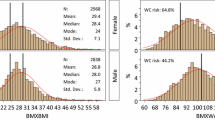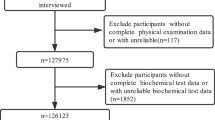Abstract
Body mass index (BMI) and waist circumference are independently associated with blood pressure, but the dependence of these associations on gender and age has not been clarified. We investigated the associations of BMI and waist circumference with systolic (SBP) and diastolic (DBP) blood pressure and assessed possible interactions with gender and age. Data concerning blood pressure and anthropometric variables were collected at enrollment in a cohort study from 10,928 non-smoking adults, all over Greece, who have never received anti-hypertensive treatment. Multiple regression-derived standardized coefficients were estimated to compare effects among variables. Among men, waist circumference appears more important than BMI in the prediction of SBP (standardized coefficients 2.26 vs. 1.52 mmHg/SD), and to a lesser extent DBP. In contrast, among women, BMI is more important than waist circumference, in the prediction of SBP (standardized coefficients 3.97 vs. 1.56 mmHg/ SD) and to a lesser extent DBP. The different effects of BMI and waist circumference on blood pressure by gender are evident among older individuals (> 55 years); among younger individuals BMI and waist circumference have comparable effects in both genders. Among younger individuals, BMI and waist circumference are independent and equally important predictors of SBP and DBP in both genders, whereas among older individuals waist circumference is the dominant predictor of blood pressure among men and BMI is the dominant predictor of blood pressure among women. Associations are more evident with respect to SBP than DBP.
Similar content being viewed by others
References
Daly PA, Solomon CG, Manson J. Risk Modification in the Obese Patient. In: Manson J, Ridker P, Gaziano JM, Hennekens C (eds), Prevention of myocardial infarction. New York/Oxford: Oxford University Press, 1996: 203–240.
WHO Consultation on Obesity. Preventing and managing the global epidemic. Geneva, World Health Organization, 1997: 1–276.
Sheehan MT, Jensen MD. Metabolic complications of obesity. Pathophysiologic considerations. Med Clin North Am 2000; 84: 363–385.
Huang Z, Willett WC, Manson JE, et al. Body weight, weight change, and risk for hypertension in women. Ann Intern Med 1998; 128: 81–88.
Manson JE, Golditz GA, Stampfer MJ, et al. A prospective study of obesity and risk of coronary heart disease in women. NEJM 1990; 322: 882–889.
Hu FB, Wang B, Chen C, et al. Body mass index and cardiovascular risk factors in a rural Chinese population. Am J Epidemiol 2000; 151: 88–97.
Kaplan NM. The deadly quartet: Upper body obesity, glucose intolerance, hypertriglyceridemia, and hypertension. Arch Intern Med 1989; 149: 1514–1520.
Bjorntorp P. Abdominal fat distribution and disease: An overview of epidemiologic data. Ann Med 1992; 24: 15–18.
Seidell JC, Cigolini M, Charzewska J, et al. Fat distribution in European men: A comparison of anthropometric measurements in relation to cardiovascular risk factors. Int J Obes Relat Metab Disord 1992; 16: 17–22.
Lyu LC, Shieh MJ, Bailey SM, et al. Relationship of body fat distribution with cardiovascular risk factors in healthy Chinese. Ann Epidemiol 1994; 6: 434–444.
Ledoux M, Lambert J, Reeder BA, et al. A comparative analysis of weight to height and waist to hip circumference indices as indicators of the presence of cardiovascular disease risk factors. Canadian Heart Health Surveys Research Group. CMAJ 1997; 157(Suppl 1): 32–38.
Okosun IS, Prewitt TE, Cooper RS. Abdominal obesity in the United States: prevalence and attributable risk of hypertension. J Hum Hypertens 1999; 13: 425–430.
Barret-Connor E, Khaw K, Chir MBB. Cigarette Smoking and Increased Central Adiposity. Ann Intern Med 1989; 11: 783–787.
Shimokata H, Muller DC, Andres R. Studies in the distribution of body fat. III. Effects of cigarette Smoking. JAMA 1989; 261: 1169–1173.
Troisi RJ, Heinold JW, Vokonas PS, et al. Cigarette smoking, dietary intake, and physical activity: Effects on body fat distribution-The Normative Aging Study. Am J Clin Nutr 1991; 53: 1104–1111.
Hays JT, Hurt RD, Dale LC. Smoking cessation. In: Manson J, Ridker P, Gaziano JM, Hennekens C (eds), Prevention of myocardial infarction. New York/ Oxford: Oxford University Press, 1996, 99–129.
Riboli E, Kaaks R. The EPIC project: Rational and study design. Int J Epidemiol 1997; 26 (Suppl 1): S6–14.
Costacou T, Bamia C, Ferrari P, et al. Tracing the Mediterranean diet through principal components and cluster analyses in the Greek population. Eur J Clin Nutr 2003; S7 (11): 1378–1385.
Rothman K. Modern epidemiology. Boston: Little, Brown, 1986.
Pouliot MC, Despres JP, Lemieux S, et al. Waist circumference and abdominal sagittal diameter: Best simple anthropometric indexes of abdominal visceral adipose tissue accumulation and related cardiovascular risk in men and women. Am J Cardiol 1994; 73: 460–468.
Lemieux S, Prud'homme D, Tremblay A, et al. Anthropometric correlates to changes in visceral adipose tissue over 7 years in women. Int J Obes Relat Metab Disord 1996; 20: 618–624.
Taylor RW, Keil Debbie, Gold EJ, et al. Body mass index, waist girth, and waist-to-hip ratio as indexes of total and regional adiposity in women: evaluation of receiver operating characteristic curves. Am J Clin Nutr 1998; 67: 44–49.
Lissner L, Bjorkelund C, Heitmann BL, et al. Larger hip circumference independently predicts health and longevity in a Swedish female cohort. Obes Res 2001; 9: 644–646.
Seidell JC, Perusse L, Despres JP, et al. Waist and hip circumferences have independent and opposite effects on cardiovascular disease risk factors: The Quebec Family Study. Am J Clin Nutr 2001; 74: 315–321.
Ho SC, Chen YM, Woo JL, et al. Association between simple anthropometric indices and cardiovascular risk factors. Int J Obes Relat Metab Disord 2001; 25: 1689–1697.
Tuomilehto J, Marti B, Kartovaara L, et al. Body fat distribution, serum lipoproteins and blood pressure in middle-aged Finnish men and women. Rev Epidemiol Sante Publique 1990; 38: 507–515.
Molarius A, Seidell JC, Visscher TL, et al. Misclassifi-cation of high-risk older subjects using waist action levels established for young and middle-aged adults-results from the Rotterdam Study. J Am Geriatr Soc 2000; 48: 1638–1645.
Croft JB, Strogatz DS, Keenan NL, et al. The independent effects of obesity and body fat distribution on blood pressure in black adults: The Pitt County study. Int J Obes Relat Metab Disord 1993; 17: 391–397.
Lemieux S, Prud'homme D, Nadeau A, et al. Sevenyear changes in body fat and visceral adipose tissue in women. Assosiation with indexes of plasma glucoseinsulin homeostasis. Diabetes Care 1996; 19: 983–991.
Report of the WHO Expert Committee. Physical Status: The use and interpretation of anthropometry. WHO Technical Report Series, 854. Geneva, 1995. 808
Usued WA, Bucahnan TA. Obesity and hypertension. Endocrinol Metab Clin North Am 1994; 23: 405–427.
Reaven GM. Syndrome X: 6 year later. J Intern Med 1994; 236: 13–22.
Moller DE, Flier JS. Insulin resistance-mechanisms, syndrome and implications. N Engl J Med 1991; 325: 938–948.
Roth JL, Mobarhan S, Clohisy M. The Metabolic Syndrome: Where are we and where do we go? Nutr Rev 2002; 60: 335–337.
Grundy SM. Hypertriglyceridemia, insulin resistance, and the metabolic syndrome. Am J Cardiol 1999; 83: 25F–29F.
Minehira K, Tappy L. Dietary and lifestyle interventions in the management of the metabolic syndrome: Present status and future perspective. Eur J Clin Nutr 2002; 56: 1264–1269.
Riccardi G, Rivellese AA. Dietary treatment of the metabolic syndrome-the optimal diet. Br J Nutr 2000; 83 (Suppl 1): S143–148.
Rowe JW, Minaker KL, Pallote JA, et al. Characterization of the insulin resistance of aging. J Clin Invest 1983; 71: 1581–1587.
Bjorntorp P. The regulation of adipose tissue distribution in humans.Int J Obes Relat Metab Disord 1996; 20: 291–302.
Haffner SM, Valdez RA, Stern MP, et al. Obesity, body fat distribution and sex hormones in men.Int J Obes Relat Metab Disord 1993; 17: 643–649.
Author information
Authors and Affiliations
Rights and permissions
About this article
Cite this article
Benetou, V., Bamia, C., Trichopoulos, D. et al. The Association of Body Mass Index and Waist Circumference with Blood Pressure Depends on Age and Gender: A Study of 10,928 Non-Smoking Adults in the Greek EPIC Cohort. Eur J Epidemiol 19, 803–809 (2004). https://doi.org/10.1023/B:EJEP.0000036582.38987.ca
Issue Date:
DOI: https://doi.org/10.1023/B:EJEP.0000036582.38987.ca




